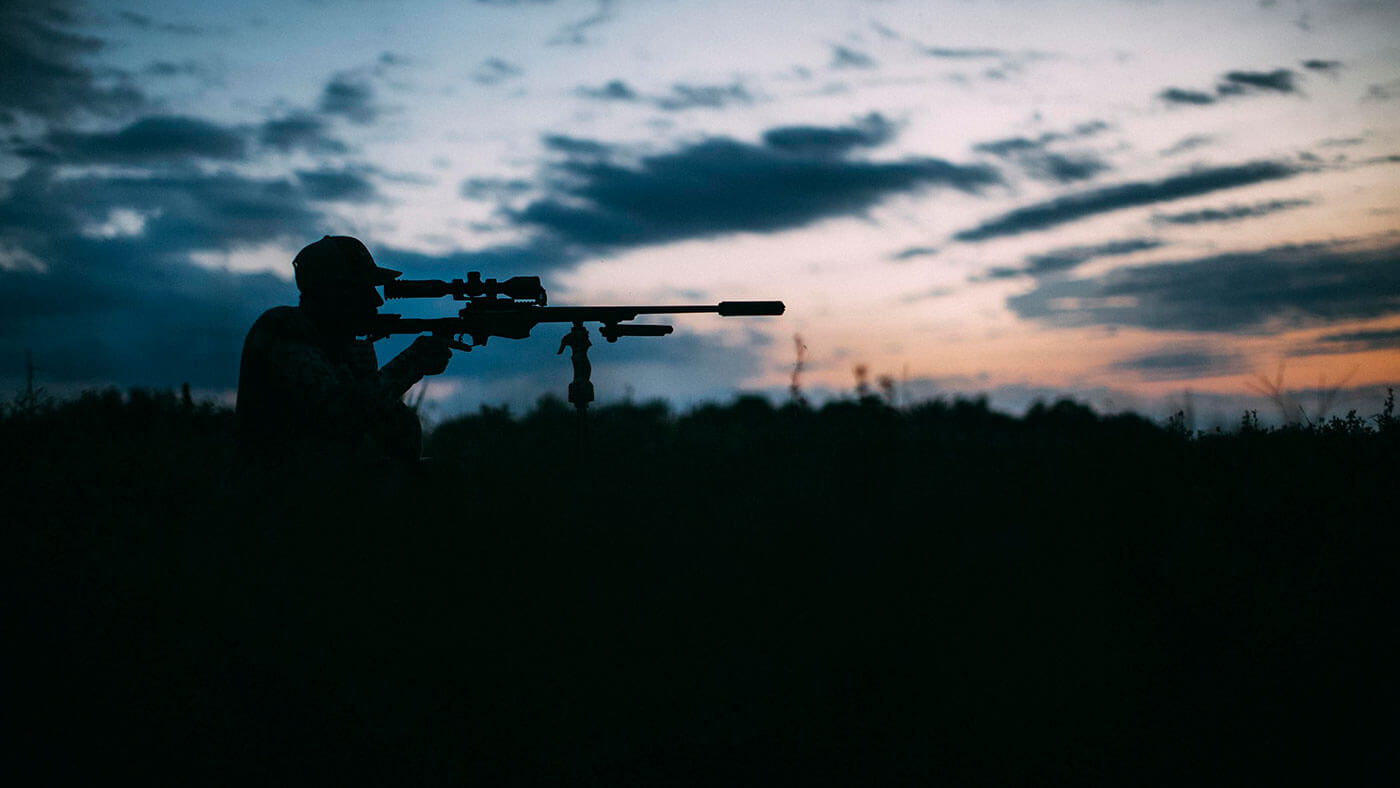- Savage Blog
- Night Hunting is Heating Up with Thermal Optics
Night Hunting is Heating Up with Thermal Optics

Ask any coyote hunter with more than a decade of experience about night hunting and how difficult it was to hunt coyotes at night long ago and you're sure to hear tales of woe and lament.
"It used to be we would only hunt at night if there was snow on the ground, there was a full moon, and it wasn't cloudy and overcast," said Dwayne Jones, who hunts coyotes on the farmlands and fields of north-central Indiana. "At most, we'd be lucky if we could get those conditions to line up 10 nights a year. Everything had to be perfect."
Times have certainly changed. You could argue we are currently in the "good old days" of night hunting for predators. Incredible and rapid technological advances in firearms, ammunition, and optics have combined with healthy varmint populations and a retooling of numerous hunting regulations to make night hunting in the 21st century as robust and accessible as ever.
It's been a relatively quick sprint from the challenging moonlight night hunts of yesteryear to the halcyon days of now. And before the hardscrabble beginnings of night hunting for coyotes fade to exaggerated tales told in wistful voices around a campfire, let's take a look at how it started, where we sit currently, and where we might be going.

NIGHT MOVES
Sure, long before the modern era of wildlife management, humans used the cover of darkness to harvest animals and feed their families. But by the 20th century, when wildlife agencies began to codify hunting seasons and the fair chase ethic took hold, virtually all forms of night hunting were prohibited in a wide swath of states.
It's important to note that it wasn't until after the end of World War II that there even were Eastern coyote populations to hunt. Throughout much of the U.S., bans on all forms of night hunting were in place to help protect populations of popular game animals – more specifically, deer.
Some – but not all – Western states were the early leaders in allowing night hunting. Coyote populations were long established, and wild hogs began to pose an ecological threat to the habitat. Night hunting was adopted as an effective way to control these critters.
But even today, night hunting rules and regulations remain inconsistent. Many states, including Arkansas, Colorado, Hawaii, New Mexico, and Tennessee, ban night hunting altogether. We probably don't have to remind you, but before even thinking of going on a night hunt for coyotes, make sure it's legal where you intend to hunt. You'll need to make sure your firearms and optics are also in compliance.
Some states allow night hunting but continue to ban the use of thermal optics and night vision optics. There are, however, gains being made. Take a look at Pennsylvania, for instance. In November 2020, the Keystone State made it legal for handheld and sporting-arm-mounted night vision and thermal optics to be used when hunting raccoons, bobcats, foxes, coyotes, and assorted other varmints.
"There are a bunch of reasons why using thermal optics for predator hunting is a really good idea," said Jones. "I'm just glad I live in a state that allows it."
STRUGGLES AND CHILL
Even on those perfect nights of long ago, when there was a full moon and snow on the ground, hunting coyotes was often an exercise in futility.
"Our percentages of success were not sky high," said Eric Mayer, founder and editor of Varminter Magazine, who does the bulk of his hunting in northern Nevada and southern Idaho "It was fun and challenging, but it was always a bit of a struggle."
The use of handheld lights, where legal, helped those hunting at night, but they came with lots of drawbacks.
"We've used a big 9-volt flashlight or one of those huge million candlepower flashlights, but it's certainly not ideal," said Mayer. "A lot of times if you turn it on a coyote and it's looking right at you, that bright light spooks the heck out of them, and you can never get a shot off."
As coyote hunters are quick to point out, the opportunities to pull a trigger on a hunt can be few and far between. When you finally get all the conditions in your favor, your calling perfect, and get a coyote to commit to coming within range, having them scurry off because the light scared them can be frustrating.
For Jones, the use of spotlights was less-than-ideal for another reason. Safety. Jones said with lights you can never be sure just how far away the target was and rarely were you able to be 100 percent sure what was behind your target.
"That just outright violates a couple of the standing rules of safe hunting," Jones said, who also said identifying the target was a challenge. "We never illegally shot a fox, but the possibility of that happening was always there when you had just a few seconds to see your target in the spotlight."
NIGHT VISION ARRIVES
Although night vision goggles were first used by soldiers in the 1930s, it wasn't until the Vietnam War that technological advances accelerated, and their use became more common. By the 21st century, night vision optics had migrated from the military background and began to gain a small toehold with predator hunters. The older night vision devices utilize a process known as optoelectronic image enhancement. It works by sensing small amounts of infrared light reflected off objects and then electrically amplifying that light into a glowing green image. Still, that can make it tough to properly identify a target.
A newer technology in night vision optics is called digital image enhancement. That process collects available light on a digital image sensor and digitally enhances the images in a full-color display. It's better, but their high costs and low supply put night vision optics out of reach for most hunters.
"I had a buddy in law enforcement who got his hands on a night vision monocular, and we started using that on our coyote hunts," said Jones. "It got to the point where if we didn't have that monocular with us, I didn't want to go."
But night vision optics – even with the new digital technology – have drawbacks. Chief among them is that the quality of the image in the optics is at the mercy of the amount of ambient, or nearby, light. If the night is overcast, or if there's no light from the moon or stars, the clarity of the image severely deteriorates.
NEXT GENERATION
In the last few years, however, cutting-edge infrared thermal imaging scopes like those produced by AGM Global Vision have brought night hunting for predators to a new level that few hunters imagined was attainable.
"Thermal imaging optics are a game-changer," said Cashe Carlson, who also writes for Varminter Magazine. "You can see your target clearly and you can hunt in places that you never thought possible. It's amazing how far along thermal imaging technology pushed night hunting."
Jones used thermal imaging scopes, which don't rely on ambient light to enhance the image, to film a coyote hunt he did recently in Indiana. He said he was floored by the clarity delivered by the scopes and monoculars the team used.
"We hunted a 400-acre field in a river bottom and as we set up, there were eight or ten deer that drifted into the field," Jones said. "Even at 300 yards you could see the antlers on the bucks and tell what class of whitetail was out there. The clarity, the quality, it was just so amazing."
Another bonus to thermal imaging scopes, said Jones, is how easy they can switch from one rifle to another.
"It doesn't get much easier," Jones said. "We had a Savage Axis II Precision in 6.5 Creedmoor, an Impulse Hog Hunter in .308, and a 110 Scout in .223. We could site them in very easily, save the profiles and swap the scope between guns in a snap."
WHAT'S NEXT?
Opportunities for night-hunting coyotes are certainly expanding. Ammo companies are producing widely available loads tailored for predator hunters. Optic companies are making scopes designed specifically for night hunting. Firearm companies are cranking out leading-edge, sweet-shooting varmint guns. State wildlife agencies are slowly changing regulations.

"It seems more hunters are giving it a try," said Carlson. "The technology is getting better and less expensive."
Jones, who's now taking his son along with him, said setting up for coyotes at night is quickly becoming one of his favorite hunts.
"When the set-up is right, the wind is right, and you get coyotes that want to respond to your calling, it's pretty special," Jones said. "It really is a blast."


